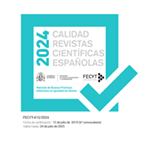Submissions
Submission Preparation Checklist
As part of the submission process, authors are required to check off their submission's compliance with all of the following items, and submissions may be returned to authors that do not adhere to these guidelines.-
Originality: Submitting an article to this journal implies the acceptance of the Declaration of Originality and Authorship.
Download file - Submission Anonymization and Data Sheet: Manuscripts will be submitted fully anonymized, following the formal requirements and detailed guidelines provided in the Submission Templates for each section. Additionally, authors are required to upload a file containing the information specified in the Data Sheet. Submissions that do not comply with this formality will be rejected before entering the review process.
- Proofreading Certificate: Submissions written in a language other than the author's native language must be accompanied by a certificate of editing, revision, and/or translation. The use of online spell checkers or AI applications does not constitute an exemption from this requirement.
- Submission format: The text format of the articles must be in accordance with the Submission Templates available to the authors. The length will be adjusted to the section to which the submission is made as indicated in Section Policies.
- Figures, tables, illustrations and graphs: all have been included in their proper place in the text, and not at the end. The original or higher quality versions are provided in the Additional Files section in the open journal system (ojs), which can be accessed during the manuscript submission process.
- Research Data Deposit Policy: Teknokultura recommends that authors deposit the data or resources (qualitative and/or quantitative) used in the preparation of their article in public repositories of their own academic institutions or FAIR repositories (e.g., Zenodo). These materials may include bibliographic lists, tables, images, observation protocols, interview scripts, or, among other possibilities, the prompts used in searches and bibliographic queries assisted by AI applications. The deposit of data or these other research materials will be considered during the evaluation process as an additional merit, especially for texts submitted to the “Karpeta” section. If data sharing is not possible, the authors must briefly explain the reason for their decision in their specific case. More information and examples on how to proceed with the deposit are available here.
- Keywords : the document must include a minimum of three and a maximum of five keywords in the same language as the article and in English. Keywords should not include words that are included in the title of the article but should appear in the abstract. The keywords should be arranged in alphabetical order and separated by semicolons. At least three of the keywords must be from the UNESCO Thesaurus http://vocabularies.unesco.org/browser/thesaurus/es/.
- Translation of metadata (title, abstract, keywords): meet the quality and correctness requirements of an academic publication. It is recommended that translations be reviewed by competent persons (native or bilingual).
-
Authorship contribution statement: specify the contribution of each author according to the taxonomy of contributions and their headings included in the following table of contributions.
-
AI Policy: By submitting a manuscript to Teknokultura, authors acknowledge and agree to comply with the journal’s AI usage policy. This policy prohibits listing artificial intelligence systems as authors or co-authors under any circumstances. The use of AI tools is permitted solely for limited editorial assistance—such as enhancing clarity and readability—and must not extend to content generation or conceptual contributions. If AI tools are employed, their use must be explicitly disclosed in the Methods section of the manuscript and appropriately cited following current APA guidelines (7th edition). Additionally, if_
Copyright Notice
In order to support the global exchange of knowledge, the journal Teknokultura is allowing unrestricted access to its content as from its publication in this electronic edition, and as such it is an open-access journal. The originals published in this journal are the property of the Complutense University of Madrid and any reproduction thereof in full or in part must cite the source. All content is distributed under a Creative Commons Attribution 4.0 use and distribution licence (CC BY 4.0). This circumstance must be expressly stated in these terms where necessary. You can view the summary and the complete legal text of the licence.
Privacy Statement
Basic information on treatment data protection: Publications Service
| Controller | Vicerrectorado Cultura y Deporte y Extensión Universitaria, +info |
| Purpose | Dissemination and sale of UCM’s publishing/ billing and shipping of publications +info |
| Legitimacy | Mission in public interest; execution of a contract +info |
| Recipients | No data will be transferred to third parties, except legal obligation +info |
| Rights | Access, rectify and erasure data, as well as other rights, explained in the additional information +info |
| Additional information | You can find more detailed information on our website: https://www.ucm.es/file/info- |













